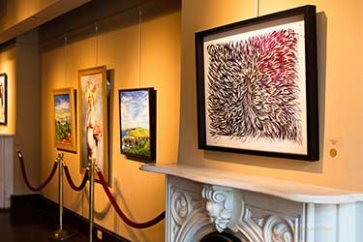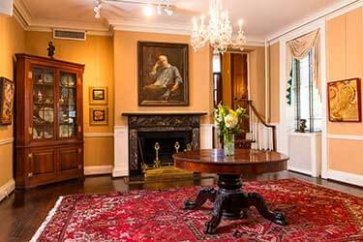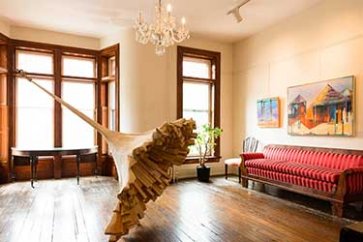The Monroe House

A Prominent Early American Home
When Timothy Caldwell, a wealthy businessman from Philadelphia, decided in 1806 to build “the most handsome house in the Capital City,” little did he dream that it would one day serve as home for President Monroe, ambassadors foreign and domestic, the nation’s first weatherman, and the city’s oldest club devoted to the arts. But that and more is what history had in store for the elegant red brick Federal townhouse that the Arts Club calls home.
The Executive Mansion
Secretary of State James Monroe and his wife Elizabeth came to live here in 1811, and tastefully furnished their home with objects acquired in Paris where Monroe served as America’s minister. Following the burning of the White House during the War of 1812, the residence became the city’s center of social activities. Dolley Madison was a frequent guest.
In March 1817, it would gain greater luster when James Monroe was inaugurated as the nation’s fifth chief executive. During the first six months of the new administration, the president and his wife continued to make this their home until the White House was fully restored in September of that year. The first of Monroe’s Inaugural Balls was held in the spacious second-floor parlor.
Elegant Entertaining
Over the years the many lavish parties have been held at the Monroe House by the successive dignitaries that lived at the elegant residence. Mrs. Benjamin Crowninshield, with of the Secretary of the Navy, wrote “Dec. 1, 1815. I think I told you we were to dinner at Mrs. Monroe’s, I Street, the day before yesterday. We had the most stylish dinner I have ever been at. The table wider than we have, and in the middle a large perhaps silver waiter, with images like some Aunt Silsbee has, only more of them, and vases filled with flowers, which made a very showy appearance as the candles were lighted when we went to table. The dishes were silver and set round this waiter. The plates were handsome china – the forks silver, and so heavy that I could hardly lift them to my mouth; dessert knives silver, and spoons very heavy.”
The MacFeely House
In 1929 the Arts Club purchased the adjacent property known as the MacFeely House providing additional space to the club. The former home of Brigadier General Robert MacFeely is of Victorian style. The new house allowed for the creation of a theater room, additional galleries, and a large art studio.




